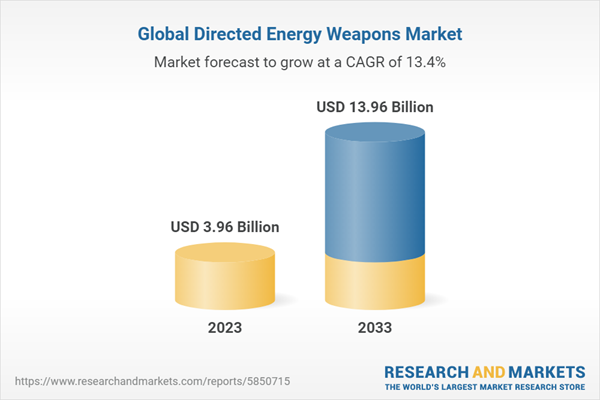Directed Energy Weapons (DEWs) are advanced, futuristic weapon systems that use concentrated energy, typically in the form of lasers or high-power microwaves, to incapacitate or destroy targets. Unlike traditional projectile-based weapons like bullets or missiles, DEWs rely on the speed of light to deliver their destructive force. These weapons have gained significant interest and investment from military and defense organizations due to their potential advantages, including precision, speed, cost-effectiveness, and reduced collateral damage.Advancements and Shifting of Directed Energy to Small Arms Could Revolutionalize the Entire Industry
High-energy laser weapons use focused laser beams to damage or destroy targets. The laser's energy heats the target's surface, causing material damage or ignition of flammable materials. HELs can be mounted on ground-based vehicles, aircraft, or ships. Microwave-based DEWs emit high-frequency electromagnetic waves to disrupt or damage electronic systems, sensors, and communication devices. These weapons can incapacitate drones, unmanned aerial vehicles (UAVs), and other electronic equipment. DEWs continue to undergo research and development, with efforts aimed at increasing power, range, and reliability. Integration with existing military systems and the development of counter-countermeasures are areas of focus. The deployment of DEWs in real-world conflict scenarios will provide valuable insights into their practicality and effectiveness. Directed Energy Weapons represent a promising technological advancement in the field of military and defense, offering a range of potential advantages in modern warfare scenarios.
TRENDS INFLUENCING DIRECTED ENERGY WEAPONS MARKET GROWTH
Many nations are prioritizing military modernization efforts, which include the development and deployment of advanced DEW systems. The focus is on upgrading defense capabilities to meet the challenges of modern warfare.The proliferation of unmanned aerial vehicles (UAVs) and drones has led to an increased demand for DEWs designed to counter these threats. DEWs can disrupt or disable drones, making them a crucial component of modern anti-drone systems.
DEWs are being integrated into naval vessels for maritime defense. These systems can target and disable incoming missiles, UAVs, and small boats, enhancing the overall security of naval operations.
Efforts are underway to make DEW systems more compact and portable. This trend allows for greater versatility, as DEWs can be deployed in various operational environments, including ground vehicles and infantry units.
DIRECTED ENERGY WEAPONS MARKET FORECAST & DYNAMICS
The directed energy weapons (DEW) market was showing promising growth potential, driven by advancements in technology, increasing military modernization efforts, and the need for more precise and cost-effective defense solutions.The DEW market was expected to witness substantial growth over the coming years, driven by a growing demand for more advanced and sophisticated defense capabilities.
Many countries and defense contractors were investing heavily in research and development to enhance DEW technologies, such as high-energy lasers and microwave-based weapons.
The ongoing military modernization efforts in various countries were a significant driver of DEW adoption. Defense organizations were looking to replace or complement traditional weapons with DEWs to enhance their capabilities.
Ongoing advancements in laser and microwave technologies were driving the development of more powerful and reliable DEW systems. These advancements were expected to improve the range, accuracy, and effectiveness of DEWs.
DEWs were being integrated into existing military platforms, including aircraft, ships, and ground vehicles, to provide a layered defense approach and enhance mission success.
DEWs were considered cost-effective in the long run compared to traditional munitions. Their lower cost per shot and reduced logistics requirements were attractive to defense organizations.
RECENT DEVELOPMENTS
Electro Optic Systems (EOS) showcased its new directed energy and kinetic counter-drone capabilities. The demonstration involves killing drones with machine guns out to 500 meters and lasers up to 1,000 meters, all while maintaining a very high level of precision. According to EOS, the capabilities were created in Australia by Australians using a sizable Australian supply chain. The company went on to say that its anti-drone technologies demonstrate how truly sovereign capabilities can satisfy the demands of government and national defense, particularly those posed by modern and developing dangers like those in Ukraine.Table of Contents
Executive Summary
Directed energy weapons (DEWs) are a type of weapon that uses a beam of energy to damage or destroy a target. DEWs can use a variety of energy sources, including lasers, microwaves, and particle beams. DEWs can be used to target targets at long ranges, making them ideal for air defense and anti-satellite applications. DEWs can be very precise, making them ideal for disabling or destroying specific targets.Table Information
| Report Attribute | Details |
|---|---|
| No. of Pages | 150 |
| Published | July 2023 |
| Forecast Period | 2023 - 2033 |
| Estimated Market Value ( USD | $ 3.96 Billion |
| Forecasted Market Value ( USD | $ 13.96 Billion |
| Compound Annual Growth Rate | 13.4% |
| Regions Covered | Global |









